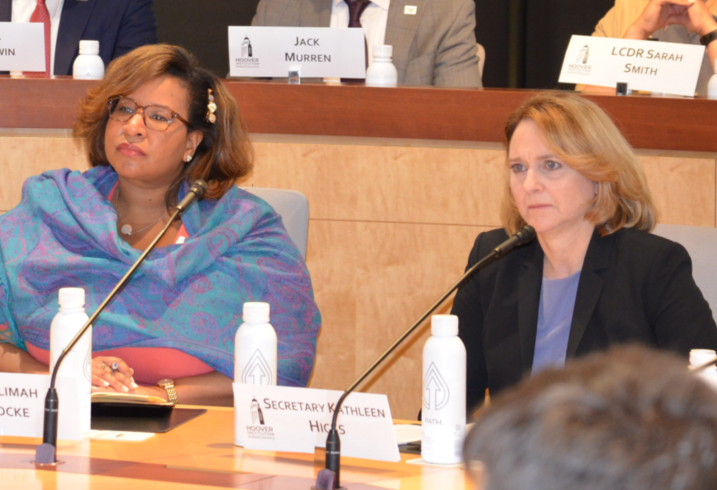Deputy Secretary of Defense Kathleen Hicks Discusses Importance of Strategic Partnerships with Stanford Faculty and Students
Deputy Secretary of Defense Kathleen Hicks Discusses Importance of Strategic Partnerships with Stanford Faculty and Students
A visit from the Department of Defense’s deputy secretary gave the Gordian Knot Center a prime opportunity to showcase how its faculty and students are working to build an innovative workforce that can help solve the nation’s most pressing national security challenges.

In a memo from March 2021, Secretary of Defense Lloyd Austin outlined new mandates for the Department of Defense to modernize, encourage innovation and “invest smartly for the future” in order to meet the dynamic threat landscape of the modern world. Writing in the same memo, he acknowledged that this goal cannot be met without the cooperation of stakeholders from across the board, including private industries and academic institutions.
In keeping with that priority, on April 5, 2022, Deputy Secretary of Defense Kathleen Hicks and her team joined a cross-departmental roundtable of faculty and students to hear more about Stanford's efforts to bring Silicon Valley-style innovation to projects at the Department of Defense and its interagencies.
These students are working under the umbrella of the Gordian Knot Center for National Security Innovation (GKC), a new program at the Center for International Cooperation and Security (CISAC) at the Freeman Spogli Institute for International Studies (FSI). GKC aims to coordinate resources at Stanford, peer universities, and across Silicon Valley’s innovation ecosystem in order to provide cutting-edge national security education and train national security innovators.
At the core of GKC is a series of classes and initiatives that combine STEM skills with policy know-how in a way that’s meant to encourage students to leverage entrepreneurship and innovation in order to develop rapid, scalable solutions to national security issues. Students from both undergraduate and graduate level programs, regardless of their prior experience in national defense, are encouraged to participate.
“We’re really trying to empower students to pursue national security-relevant work while they’re here at Stanford,” explains Joe Felter, GKC’s director, co-founder, and senior research scholar at CISAC. FSI and CISAC have deep roots in this type of innovative, interdisciplinary approach to policy solutions GKC is working to implement. Michael McFaul, FSI’s director, is a founding faculty member and principal investigator for GKC, and David Hoyt, the assistant director of GKC, is an alumnus of the CISAC honors program.
Results from GKC’s classes have been very encouraging so far. Working through "Hacking for Defense," a GKC-affiliated class taught out of the MS&E department, Jeff Jang, a new Defense Innovation Scholar and MBA student, showed how implementing a rapid interview process and focusing on problem and customer discovery has allowed his team to create enterprise software for United States Air Force (USAF) fleet management that has vastly improved efficiency, reduced errors and enabled better planning capabilities into the workflow. Their product has been given numerous grants and awards, and the team has received signed letters of interest from 29 different USAF bases across the world.





In another GKC class, "Technology, Innovation, and Great Power Competition,” Abeer Dahiya and Youngjun Kwak, along with Mikk Raud, Dave Sprague and Miku Yamada — three students from FSI’s Ford Dorsey Master’s in International Policy program (MIP) — have been tackling the challenges involved in developing a domestic U.S. semiconductor strategy. They were among the student teams asked to present the results of their work to Dep. Sec. Hicks during her visit.
“Attending this class has been one of the highlights of my time at Stanford,” says Mikk Raud (MIP ‘22). “It’s been a great example of how important it is to run interdisciplinary courses and bring people from different fields together.”
He continues, “As a policy student, it was very insightful for me to learn from my peers from different programs, as well as make numerous visits to the engineering quad to speak to technical professors whom I otherwise would have never met. After meeting with and presenting to Deputy Secretary Hicks and hearing about the work other students are doing, it really hit home to me that the government does listen to students, and it really is possible that a small Stanford group project can eventually lead into significant changes and improvements of the highest levels of policy making.”
This kind of renewed interest in national security and defense tech among students is precisely what the Gordian Knot Center is hoping to foster. Building an interconnected innovation workforce that can “think deeply, [and] act quickly,” GKC’s motto, is a driving priority for the center and its supporters.
The Department of Defense recognizes the value of this approach. In her remarks, Dep. Sec. Kathleen Hicks acknowledged that reshaping the culture and methodologies by which the DoD runs is as imperative as it is difficult.
“My life is a Gordian knot, day in and day out at the Defense Department,” she quipped. Speaking seriously, she reminded the audience of the tremendous driving power DoD has had in creating future-looking national security defenses. “Because of its sophistication, diversity, and capacity to innovate, the U.S. Defense Industrial Base and vibrant innovation ecosystem remains the envy of the world,” Hicks emphasized. “Every day, people like you are designing, building, and producing the critical materials and technologies that ensure our armed forces have what they need.”
But she also recognized that the challenges facing the DoD are real and complex. “There are many barriers in front of the Department of Defense in terms of what it takes to operate in government and to make the kinds of shifts we need in order to have the agility to take advantage of opportunities and partner effectively.” She reiterated that one of her key priorities is to accelerate innovation adoption across DoD, including organizational structure, processes, culture, and people.
Partnerships with groups like the Gordian Knot Center are a key component to breaking down the barriers to innovation facing our national institutions and rebuilding them into new, more adaptable bridges forward. While the challenges facing the Department of Defense remain significant, the work of the students in GKC’s classes so far proves that progress is not only possible, but can be made quickly as well.






